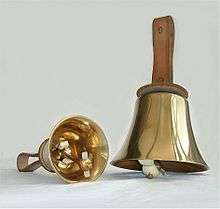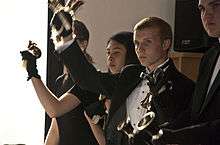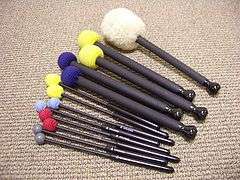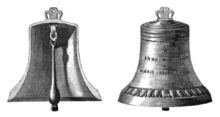Handbell
 | |
| Percussion instrument | |
|---|---|
| Classification | Percussion |
| Hornbostel–Sachs classification |
111.242.222 (Sets of clapper bells) |
| Inventor(s) | Robert and William Cor |
| Developed | 1696 - 1724 |
| Related instruments | |
A handbell is a bell designed to be rung by hand. To ring a handbell, a ringer grasps the bell by its slightly flexible handle - traditionally made of leather, but often now made of plastic - and moves the wrist to make the hinged clapper inside the bell strike. An individual handbell can be used simply as a signal to catch people's attention or summon them together, but handbells are generally heard in tuned sets.
History
The first tuned handbells were developed by brothers Robert and William Cor in Aldbourne, Wiltshire, England, between 1696 and 1724.[1] The Cor brothers originally made latten bells for hame boxes,[2] but for reasons unknown, they began tuning their bells more finely to have an accurate fundamental tone, and fitted them with hinged clappers that moved only in one plane.[1]
Originally, tuned sets of handbells, such as the ones made by the Cor brothers, were used by change ringers to rehearse outside their towers. Tower bell ringers' enthusiasm for practicing the complicated algorithms of change ringing can easily exceed the neighbours' patience, so in the days before modern sound control handbells offered them a way to continue ringing without the aural assault. The handbell sets used by change ringers had the same number of bells as in the towers - generally six or 12 tuned to a diatonic scale.[3]
Handbells were first brought to the United States from England by Margaret Shurcliff in 1902. She was presented with a set of 10 handbells in London by Arthur Hughes, the general manager of the Whitechapel Bell Foundry after completing two separate two-and-a-half-hour change ringing peals in one day.[4]
Terminology

The bells used in American handbell choirs are almost always English handbells. "English handbells" is a reference to a specific type of handbells, not to the country of origin. While some American handbell choirs do use bells made in England, the majority play bells made either by Malmark Bellcraftsmen or by Schulmerich Bells, both based in Pennsylvania.[5]
In the United Kingdom, there is a distinction between "American handbells" and "English handbells" - "English handbells" are traditional, with leather clapper heads and handles (such as the bells Whitechapel makes), while "American handbells" use modern materials, such as plastic and rubber, to produce the same effect (such as those produced by Malmark and Schulmerich). In America, however, they are all called English handbells.
Characteristics
The two major defining characteristics of English handbells are their clappers and ability to produce overtones. The clapper on an English handbell is on a hinge and moves back and forth in a single direction, unlike a school bell in which the clapper swings freely in any direction. It also has a spring that holds the clapper away from the casting after the strike to allow the bell to ring freely. Furthermore, the shaft of the clapper is rigid, such that the bell may be held with its mouth facing upward. The overtones on an English handbell are a 12th (an octave and a perfect fifth) above the fundamental, while Dutch handbells - such as Petit & Fritsen - focus on the overtone a minor 10th (an octave and a minor third) or a major 10th (an octave and a major third) above the fundamental.
Handbells can weigh as little as 7 oz (200 g) or upwards of 18 lb (8.2 kg).[6]
Handbell performance

A handbell choir or handbell ensemble (in the United States) or handbell team (in England) is a group that rings recognizable music with melodies and harmony, as opposed to the mathematical permutations used in change ringing. The bells used generally include all notes of the chromatic scale within the range of the bell set. While a smaller group uses only 25 bells (two octaves, G4-G6), the sets are often larger, ranging up to an eight-octave set (97 bells, C1-C9). The bells are typically arranged chromatically on foam-covered tables; these tables protect the bronze surface of the bell, as well as keep the bells from rolling when placed on their sides. Unlike an orchestra or choir in which each musician is responsible for one line of the texture, a bell ensemble acts as one instrument, with each musician responsible for particular notes, sounding his or her assigned bells whenever that note appears in the music.
Handbell music
Handbell choirs generally ring music composed or arranged specifically for the instruments because of their highly resonant sound, the limited note range of a handbell set, and the unique pitch-by-pitch division of the staff among the ringers.
There are several major publishers providing printed handbell music such as the "Hope Publishing Company", "The Lorenz Corporation" and "Alfred Music Publishing" as well as free sites from individual composers and arrangers. Costs associated with handbell music typically result from shipping (many scores are only published in hard-copy) and dissemination; as most scores do not permit duplication and must be purchased individually for each ringer in the handbell choir.
The coordination of the bell ringers requires a different approach than other ensembles. All the ringers read from a complete score. This score is similar to a piano score, but with an additional convention: The C# above middle C and all notes below are always written in the bass clef, and the Db above middle C and all notes above are always written in the treble clef. (This formatting is not always the convention for solo and small-ensemble handbell music.) Handbell music is written one octave lower than the actual sound the bells make, so a "middle C bell" or bell is actually playing a note with a high C frequency.[7][8] (For simplicity, the bell would still always be referred to as middle C or as C5.)
Due to handbells' relative rarity outside of the confines of church services—although less so now than in the 1980s and early 1990s—the majority of pieces composed and arranged for handbells last approximately four minutes. A few composers and arrangers write longer and more intricate works for handbells; generally these pieces use handbells in combination with other instruments.
.jpg)
Ringing techniques
To ring a handbell, the ringer moves it in such a way that the clapper strikes the inside surface of the bell, usually holding it against his or her shoulder, bell-upwards, and then swinging the bell through an elliptical shape to cause the clapper to strike the casting of the bell. The tone of the bell will continue to resonate, decaying naturally until it stops completely, or until the ringer stops the tone by damping the bell with a hand, on the body, or on a padded surface.[9]
Handbell techniques have changed very much over the years. Donald Allured, founding director of Westminster Concert Bell Choir, is credited with fully realizing an American "off the table" style of ringing that includes many non-ringing sound effects including stopped techniques such as plucking the clapper with the bell on the table. He is also credited for promoting precise damping or stopping of the bell sound by touching the bell casting to a soft surface, in the service of more musical results.
Multiple bell techniques
Traditional ringing technique only allows one ringer to ring two bells at a time (one in each hand). Depending on the number of bells needed for a particular piece of music and the number of ringers in a choir, it may be necessary for each ringer to ring more than two bells at a time or in short succession. There are also many techniques that change the sound of the bell as it is rung.
Four bells

There are two main ways of ringing two handbells with one hand: four-in-hand and Shelley. In the four-in-hand technique, ringers hold two bells in one hand with the clappers at right angles to each other. This allows the ringer to either move the hand normally ("ring" - Primary Bell) or ring knuckles-first ("knock" - Secondary Bell) to ring two different bells independently with the same hand (for a total of four bells when ringing with both hands). The two bells can also be played together by holding the wrist at a 45 degree angle. Two opposing viewpoints exist regarding the merits of this technique: while some believe that Shelley ringing is rendered obsolete when four-in-hand is perfected, others believe that the control, balance and precision offered by Shelley ringing makes the technique more applicable in certain ringing situations (particularly those involving other techniques, such as shaking and martellato, which are nearly impossible to "perfect" with four-in-hand ringing).
In large ensembles, Four-in-hand is typically used to ring multiple positions or pick up accidentals.
Shelley ringing is similar, except that the clappers are each positioned the same direction. Using this technique, a ringer can then ring two bells simultaneously with one movement. Shelley is typically used to ring two notes, an octave apart. The motion of the clappers in the same plane makes feasible techniques which generally require this, such as martellato, vibrato and shake, all of which are difficult (if not impossible) to achieve with four-in-hand ringing. The Shelley technique can also be used to ring two notes separately by striking the primary bell sideways and the secondary bell forward in an action like tapping the fingers.[10]
Six bells
There are several ways to play six bells at a time (i.e., to ring three bells in each hand). One way is to pick two bells up as if one were Shelley ringing, then pick the third up between one's little and ring fingers (a 'triple Shelley'). All three bells ring together when ringing in a knocking motion. A second way is to pick up the third bell sideways so that the clapper swings outward. Ringers with good control can then ring the first bell without ringing the third bell, allowing the ringer to play three different notes in one hand.[11]
Weaving
Weaving is the technique of playing a succession of bells by changing which bell is in each hand as required. This is used by bass bell ringers and solo/small ensemble ringers. The large size and weight of bass bells makes four-in-hand ringing impractical and often a solo or small ensemble ringer will need to move up and down a range of bells, possibly sharing them with others. This technique means that more than two bells can be rung in short succession, using the table to damp the bell and free the hand to pick up the next bell. If the ringing sequence requires bells to be rung in tonal order, this technique often results in a weaving pattern as the ringer must often reach across their body for the next bell in the sequence.[12] Weaving can also be used in combination with the four-in-hand in a technique called "traveling four-in-hand". By combining the ability to hold two bells in each hand, with the ability to quickly drop and pick up the secondary bell of a Four-in-hand, a ringer has quick access to several bells.
Other techniques

There are other ways to play music with handbells besides traditional ringing. Other techniques include plucking, shaking (or trilling), table damping (or martellato), and malleting bells (both on the table and suspended).
Echo technique adds a brief pulse of increased volume to a sustained handbell note. This is accomplished by gently touching the rim of a vibrating bell to the padded table.[8]
Gyro is a handbell technique that involves holding the bell in a vertical position, then rotating it either clockwise or counterclockwise slowly to create a small vibrating sound. This technique can also be done horizontally to push the sound outwards.[13]
Malleting bells involves using one of several types of rubber, plastic or yarn-wrapped mallet to strike the casting of the bell. This can create a staccato tone when the casing is pressed into padding, a normal ringing tone when the bell is suspended or even a drum-roll effect when multiple mallets are used or multiple hits on the bell are played. Suspended malleting can be employed to create a bell tree which allows many bells to be played by one ringer.[14]
Martellato also creates a staccato tone and is accomplished by striking the bell into the foam-covered table in such a way that the clapper strikes the casting immediately after the bell strikes the foam. A variation, called a "Mart Lift" is accomplished by lifting the bell casting off the table very soon after the clapper strikes. This creates a staccato tone followed by a softened sounding of the bell.[8]
Plucking is accomplished by using the thumb and forefinger to force the clapper head into the casting while the bell is on the table with the handle toward the player, producing a staccato tone. Each pluck is a single note.[15]
Shaking is accomplished by rapidly ringing the bell back and forth so that the clapper strikes both the front and back of the bell casting in quick succession. This technique creates a continuous sound, as opposed to normal ringing in which the tone decays rapidly after being rung. Because of their size, bass bells are rarely shaken.[16] Instead, if a shaking sound is desired from a bass bell, the bell is suspended and a mallet roll is played.
The Singing Bell technique creates a sustained pitch similar to the sound a wine glass makes as its rim is stroked with a wet fingertip, and is accomplished in much the same way. A short wooden dowel or stick is touched to the outside of the rim of a handbell, which is being held in the other hand. The dowel is then used to stroke the rim of the bell in a circular or "stirring" motion. The Singing Bell technique is adapted from the "Singing Bowl" tradition of Tibet.[8]
A Tower Swing is when the bell is rung and then swung down and a bit behind the ringer and back up to a normal position. Doing this creates an "echo" effect. The mouth of the bell must rotate around to create the sound change that resemble a tower bell. Usually this is done over a period of three or four beats' worth of time.
Thumb damp technique provides a staccato sound similar to plucking or malleting. This is often described as a "tinkling" sound. The bell is rung normally with a thumb or several fingers touching the outside of the bell below the rim. This damps the bell's sound immediately after it is rung. With smaller bells, this technique can often be easier than plucking or malleting because the bells don't have to lay on the table.
Notation
There are a number of abbreviations and notations used exclusively or almost exclusively in handbell music:
- LV ("laissez vibrer" or "let vibrate," similar to a piano's sustain pedal)
- R ("ring," regular ringing or meaning to end the LV)
- SK ("shake," i.e. shaking the bell continuously during the duration of the note)
- TD ("thumb damp" - ringing the bell with a thumb on the casting to create a staccato note)
- PL ("pluck," which means to throw down the clapper while the bell lies on the table)
- a small, solid triangle ("martellato" - to strike bell against padding of the table, pushing the casting firmly against padding as to quickly dampen sound)
- SW ("swing" - to play the bell in a normal position, swing it down to the waist, then bring it back up)
- BD ("brush damp," brushing the rim of the bell against the ringer's chest to cause a quick diminuendo) and
- an upward arrow, usually with a curve at the bottom ("echo," - ringing the bell and then touching it very briefly to the table, creating an echo effect).[13][17]
Handbell tree
Handbells can be played as a handbell tree where the handles are interlaced within each other, allowing multiple bells to be played with mallets to obtain an undamped sound. This performance technique was invented by Louise Frier in the 1980s. It was further developed by Barbara Brocker who developed a standardized bell layout. It is practiced by many handbell soloists. The notational symbol used for Handbell Trees features a series of interlocking diagonal lines, one for each handbell used. The pitch of each bell is placed at the lowest point of each diagonal line.[8][18][19][20]
In popular culture
On the first episode of season 29 of Mister Rogers' Neighborhood, titled Noisy and Quiet, Mr. Rogers visits the Westminster Handbell Choir.[21]
In a season 1 episode of New Girl, Jess heads a youth handbell ensemble.[22]
Richie joins the school Handbell Choir in season 3 episode 3 "Popular" of The New Adventures of Old Christine[23]
Cable TV show Crescendo! by International Artists Records has been featuring Handbells since 2003. Handbells have been featured in over 138 Episodes, including Solo Handbells, Duo Handbells, Trios, Quartets, Handbell Choirs, Mass Rings, and Ensembles. Crescendo! airs on Time Warner Cable from New York City (all over the country), and on Comcast in Seattle. Online version can be viewed at Seattle Community Media[24]
See also
| Wikimedia Commons has media related to Handbells. |
See also
| Wikimedia Commons has media related to Handbells. |
Composers and arrangers
- Donald Allured
- Mark Andersen
- John Behnke
- John Dare
- Cynthia Dobrinski
- Michael Glasgow
- Derek Hakes
- Nick Hanson
- Jason Krug
- Phillip Lanier
- Emily Li
- Linda McChechnie
- Kevin McChesney
- Carol Lynn Mizell
- Hart Morris
- Cathy Moklebust
- Susy Nelson
- William Payn
- Arnold Sherman
- F. Thomas Simpson
- Larry Sue
- Valerie Stephenson
- Martha Lynn Thompson
- Sondra Tucker
- H. Dean Wagner
- Kath Wissinger
- Kevin Mazimas Ko
Performers
- Alluring Handbell Ensemble
- Austin Handbell Ensemble
- Bells on Temple Square
- Crown City Ringers
- International Artists Carillon
- Larry & Carla Sue
- Pikes Peak Ringers
- The Raleigh Ringers
- Dorothy Shaw Bell Choir
- Stafford Regional Handbell Society
- Sonos
- Tintabulations Handbell Ensemble
- The Westminster Ringers
- Embellish Handbell Ensemble
- Philadelphia Bronze
- Listing of Handbell Musicians of America member Handbell Choirs by State
- Los Angeles Buddhist Bell Choir
Soloists & Teachers
- Lynn Andersen - Soloist
- Mark Andersen - Teacher
- Christine Anderson - Soloist/Teacher
- Kathie Fink - Soloist
- Nancy Hascall - Soloist/Teacher
- Jad Johnson - Soloist
- Michèle Sharik - Soloist/Teacher
Handbell Manufacturers
- Davis & Hill Bells
- Malmark Bellcraftsmen
- Petit & Fritsen / Royal Bell-foundry Petit & Fritsen
- Schulmerich Bells
- John Taylor & Co / The Loughborough Bell Foundry
- Whitechapel Bell Foundry [25]
- Uchida Handbells
Handbell Music Publishers
- Above the Line Publishing
- AGEHR Publishing
- Alfred Publishing
- Beckenhorst Press
- Catabile Press/Genesis Press
- Choraegus
- Chorister's Guild
- Concordia
- Dare Team Press
- From The Top Publications
- GIA Publications
- High Meadow Music Publishing
- Agape/Hope Publishing
- Jeffers Handbell Supply, Inc.
- The following are associated with Jeffers Handbell Supply:
- Flagstaff Publishing
- Laurendale Associates
- Ring Out Press
- National Music Publishers
- Your Song Press
- Composers Music Company
- Red River Music
- Ring Praise Publications
- Ringing Word
- Robert Groth Publications
- Betty Price Chimes
- Service Music Press
- MeadowLark Melodies
- The following are associated with Jeffers Handbell Supply:
- The Lorenz Corporation
- The following are associated with The Lorenz Corporation:
- MorningStar Music Publishers
- Paradigm Press / David K. Tiller
- Ring Press
- Sonology Music/STEP
- The Great Christmas Ring
Handbell Umbrella Organizations
- Handbell Musicians of America (previously American Guild of English Handbell Ringers)
- The Handbell Guilds of Canada
- Alberta Guild of English Handbell Ringers
- British Columbia Guild of English Handbell Ringers
- Manitoba Guild of English Handbell Ringers
- Ontario Guild of English Handbell Ringers
- Saskatchewan Guild of English Handbell Ringers
- Handbell Ringers of Great Britain
- The Handbell Society of Australasia
- International Handbell Committee
- Korean Handbell Association
- New England Ringers
- Handbell Ringers of Japan
- Handbell Ringers of America
References
- 1 2 Markey, Willard H. (May–June 1997), "More History?: From Hame Boxes to Handbells", Overtones: the Official Journal of the American Guild of English Handbell Ringers, 43 (3): 36–37
- ↑ A hame box is a device that attaches to the top of a horse collar and contains several bells that ring when the horse moves. For more information about the Cor brothers and a picture of a hame box, see A Brief History of The Aldbourne Bell Foundries.
- ↑ Theile, Ron. "The History of Handbell Ringing". Retrieved 2009-08-13.
- ↑ Bullen, Nigel (March–April 1998), "Researching the History of Handbells: In the Beginning", Overtones: the Official Journal of the American Guild of English Handbell Ringers, 44 (2): 37–38
- ↑ http://www.npr.org/blogs/money/2013/12/23/256568061/the-great-handbell-war
- ↑ http://www.olypen.com/nwbell/handbell/sidenote/bell_weights.html, accessed 10/09/09
- ↑ Schmidt-Jones, Catherine. "Transposing Instruments". Retrieved 2008-03-08.
- 1 2 3 4 5 The American Guild of English Handbell Ringers, Handbell and Handchime Notation. AGEHR 2010
- ↑ Moore, Daniel K. (May–June 1998), "Technique-ly Speaking: The Basic Ringing Stroke/Shoulder Damp", Overtones: the Official Journal of the American Guild of English Handbell Ringers, 44 (3): 10–11
- ↑ Leonard, Karen E. (September–October 2000), "Technique-ly Speaking: Shelley Ringing", Overtones: the Official Journal of the American Guild of English Handbell Ringers, 46 (5): 13–14
- ↑ Anderson, Christine (2000-01-14). "Multiple Bells In-Hand". Retrieved 2009-08-13.
- ↑ Allured, Don (May–June 1999), "Technique-ly Speaking: The Weave and Other Multiple Bell Doings", Overtones: the Official Journal of the American Guild of English Handbell Ringers, 45 (3): 41–44
- 1 2 "Handbell Notation Symbols & Definitions". Handbell World. Retrieved 24 October 2015..
- ↑ Frier, Louise (September–October 1999), "Technique-ly Speaking: Malleting Suspended Handbells", Overtones: the Official Journal of the American Guild of English Handbell Ringers, 45 (5): 14–16
- ↑ http://www.ling.upenn.edu/~kingsbur/articulations.html. Retrieved 2009-10-09.
- ↑ Ebling-Thorne, Kathy (September–October 1998), "Technique-ly Speaking: The Shake and The Trill - What a Thrill!", Overtones: the Official Journal of the American Guild of English Handbell Ringers, 44 (5): 9–10
- ↑ http://www.ling.upenn.edu/~kingsbur/articulations.html, accessed 10/09/09
- ↑ Tipton, Nancy (6 September 2011). "proper term". emp-handbell-l (Mailing list). Retrieved 7 September 2011.
- ↑ "The Founder". Belltrees and More, Inc. 2009–2010. Retrieved 7 September 2011.
- ↑ "Barbara Brocker Bio". choraegus. 31 January 2011. Archived from the original on May 5, 2014. Retrieved 3 May 2014.
- ↑ "1736: Noisy and Quiet". IMDb. Retrieved 8 August 2015.
- ↑ "Bells". IMDb. Retrieved 8 August 2015.
- ↑ "Popular". IMDb. Retrieved 30 August 2016.
- ↑ "Crescendo!". IMDb. Retrieved 30 August 2016.
- ↑ http://www.whitechapelbellfoundry.co.uk/
